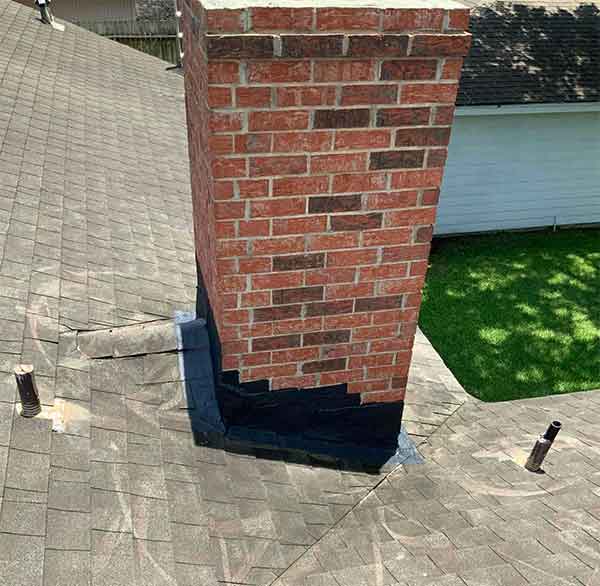We Specialize In Chimney Flashing Installation & Repair
Damp and musty smells, water spots, the annoyingly constant drip…drip…drip coming from your fireplace… Few things are worse than a leaky chimney. Especially when that hot Houston weather gives way to the slight cool breeze of fall and all you want to do is kick back, relax, and enjoy some family time in front of the fireplace.
If you’re suffering from a leaky chimney, it’s possible that your flashing is to blame. Fortunately for homeowners in the greater Houston and Beaumont areas, Lords Chimney is here to help.
In business for two decades, we know our way around a chimney. Our team of experts is highly trained, experienced, and certified by the Chimney Safety Institute of America (CSIA), so no matter what’s thrown our way, we’re sure to have a solution. From regular annual maintenance services, like chimney cleanings and inspections, to more intensive repairs and rebuilds, we’re equipped and ready to help with it all.
You can request an appointment online, or give us a call at 281-497-4000 to learn more about us, our services, and what we can offer you.

Get Your Free Virtual Assessment Today!
What Is Chimney Flashing?
Flashing is the band of sheet metal that surrounds the area where your chimney and roof meet. It is designed (and should be installed in such a way) to create a waterproof barrier where there would otherwise be a gap between the roof and the chimney. If not installed accurately, the flashing can be one of the most problematic areas of a chimney. In fact, when a customer informs us that their chimney is leaking, the flashing is one of the very first things we check.
Rusty nail holes, loose caulking, inferior materials, and general wear and tear over the years can allow water to leak through flashing. Also, too often, chimney flashing isn’t installed by a professional – or has been shoddily installed by someone who claims to be a professional – and will soon begin to leak. A leaking chimney can spell big trouble, especially if it goes too long undetected or ignored.
If you think your chimney may be leaking from the flashing or perhaps because of something else, call Lords Chimney. We can make sure that your existing flashing doesn’t leak, and in the case that it is the leaking culprit, we’ll either repair your old stuff or replace it with something new and better. This is normally a relatively easy and inexpensive fix when done by trained and experienced professionals.
And as far as professionals go, in the Houston area, there is no one better than Lords when it comes to all things chimney and fireplace. We believe every home should feel like a palace and we’re here to make that dream a reality. Give us a call to learn more or request your next appointment online.
What Does Flashing Do? How Does It Work?
Acting as a waterproof barrier at the junction where your chimney and your roof meet, when installed correctly, flashing ensures that water is not permitted to sneak through any gaps. There might be a lot of common causes for a variety of chimney damages, but water? That’s enemy number one. While the chimney cap may be the first layer of defense against water and moisture damage when it comes to the top of the entire chimney structure, flashing is the same for the base of the chimney’s structure – as well as the roof and the rest of the home.
Remember, a chimney is not inherently and of itself part of a house. Your roof and chimney are two distinct structures that come together – with a variety of different parts and components – to form a home.
Regardless of whether the chimney is on the outside of a home or somewhere in the middle, there must be precautions in place, both to ensure the fireplace system has the space and breathability it needs to operate properly and efficiently, as well as to remain protected against water penetration.
While flashing’s main purpose may be simple – to keep water out and away from that crucial place where two structures intersect – the construction, installation, and maintenance is best left to someone who understands the layering techniques required to waterproof a chimney for the long-term. Trust the professionals at Lords Chimney for it all.
Ask About Financing Options!
Get Your Estimate Today!
Are There Different Kinds of Flashing?
Yes, there are. In fact, did you know that flashing isn’t used exclusively for chimneys? It’s installed on a roof wherever there is a penetrative structure poking through, like piping or other vents, skylights or windows, and more. Constructed from sheet metal and installed using different pieces in several layers, the flashing can vary both in material and installation method.
When it comes to a chimney structure, a chimney technician will install the flashing in three steps to ensure the seal they create is watertight:
- Step flashing: A little difficult to see clearly from the ground, step flashing is what we call the pieces of sheet metal bent into an elongated “L” shape (resembling a sort of hinge structure) that are installed along the base of the chimney and under the surrounding roof tiles. This is crucial in ensuring that the initial gap between chimney and roof is completely covered.
- Counter/cap flashing: Installed as a second layer of defense, this next step is called counter or cap flashing. This kind of chimney flashing is affixed directly onto your chimney which ensures that no water will sneak through and penetrate under the step flashing. Depending on the type of chimney you have, it will either be caulked into the existing mortar joints between the brickwork or permanently attached in another way (for prefab models), thus redirecting water out and away from the chimney.
- Base flashing: As the name suggests, this kind of flashing is installed around the base of the chimney and reinforces any gaps, cracks, or separations between the other types of flashing, as well as the structures themselves.
Without proper installation of all three of these types of flashings, a leaky chimney is inevitable.
Do I Call a Roofer or Chimney Technician for Flashing Installation?
It’s important to note that there is a discrepancy in the home services realm about who to call for flashing repairs: roofers or chimney specialists.
While we don’t have the authority to make any “official” call, if you’re asking, we believe that it is always better to call in a company who knows chimneys to install, repair, or check up on chimney flashing.
Why? Because while technically, the chimney flashing is part of the roofing process, it is also considered a vital component to the chimney system’s overall structure. And who knows chimneys better and how best to protect and care for them than a chimney service company?
Are you worried your flashing might be in disrepair or have perhaps experienced some chimney leaks that you suspect might be a result of improper flashing installation? Or, are you looking for something else chimney- or fireplace-related? Time to schedule that annual inspection or chimney sweep? Trust the team of professionals at Lords Chimney for it all. Request an appointment through our website, or give us a call at 281-497-4000 to schedule a service with us.
What Kinds of Materials Are Used for Chimney Flashing?
For the most part, when it comes to chimney parts that are usually constructed from metal, there is a small number of metals that work well. Remember, all of the parts and pieces of your system that are out and exposed to the elements need to be made of such a material that will not damage easily or wear extensively under a variety of weather and temperature conditions.
For this reason, the kinds of metal used the most for chimney flashing installations are:
- Aluminum: Quite soft when it comes to metals, aluminum is only a flashing material option if it has been properly treated and coated with a waterproof agent. Otherwise, it will quickly degrade after only a few rainfalls.
- Copper: While not as soft as aluminum, copper is still a malleable material that can be bent into the different shapes required in the chimney flashing installation process. However, copper also oxidizes over time, changing the color of the metal from a warm gold to a pale green, which some people prefer.
- Steel: In many ways the best option of the three, steel is strong, sturdy, and durable in addition to being corrosion-resistant (if appropriately galvanized before the installation process).
Don’t worry if you’re not sure which material you’d prefer – that’s where we come in with advice and expertise to help ensure your home is both properly protected and adheres to your individual style preferences. Give us a call to set something up!
How Do I Know if My Chimney Flashing Is Damaged?
Well, that’s just it – you don’t. Not unless you’ve had a professional out to visit your home and informed you of such. Sure, there are ways to determine if your chimney is leaking, but even in these instances, unless you go up to the roof to investigate (which we do not advise or condone), it’s impossible for you to know where the leak is coming from. After all, a leak is a leak – the results of which will be the same no matter where the root cause is.
So, how can you know for sure if it’s broken or rusted flashing causing your problems? By giving us a call and booking an appointment with our team of sweeps. We’ve got your back.
Can I Install or Repair My Own Flashing?
You really should not. Yes, there are a ton of guides and “how to” videos out there on “proper chimney flashing installation” and “DIY chimney flashing repair,” but at the end of the day, would you rather:
- experiment and potentially make matters worse?
- consult a professional chimney technician and get things taken care of properly and efficiently?
We’ll give you a hint: the second option is much more favorable. That is why we went into this business in the first place – to make the homes in our community as safe and cozy as possible.
Give Us a Call Now
If you’re ready to take care of that leak once and for all, you’ve found the right company to do it. Call on Lords Chimney at 281-497-400 – or fill out our appointment request form right here on our website – for all matters concerning your chimney and fireplace. We can’t wait to work with you.
If you have a prefab chimney, a new chase cover may be the route to your chimney leak repairs.

